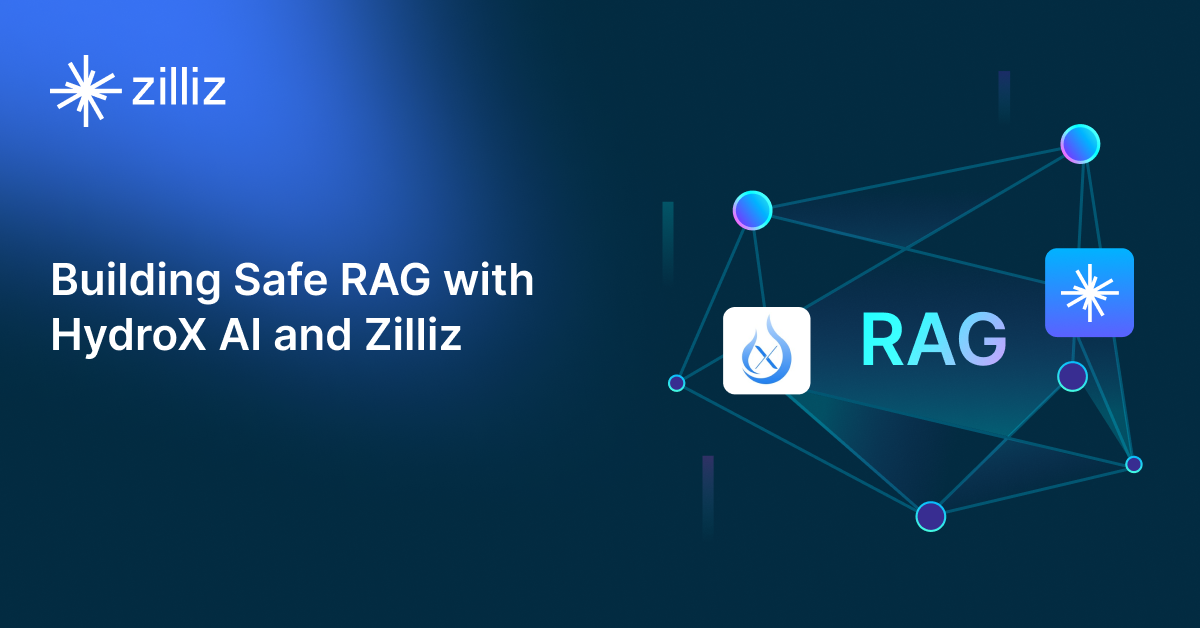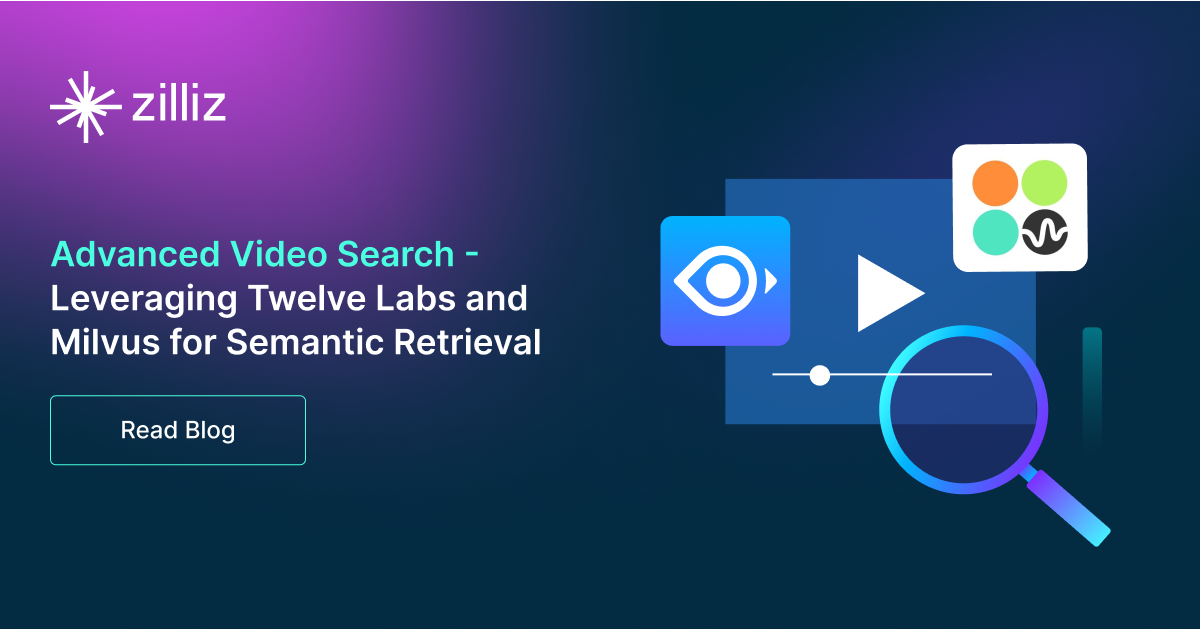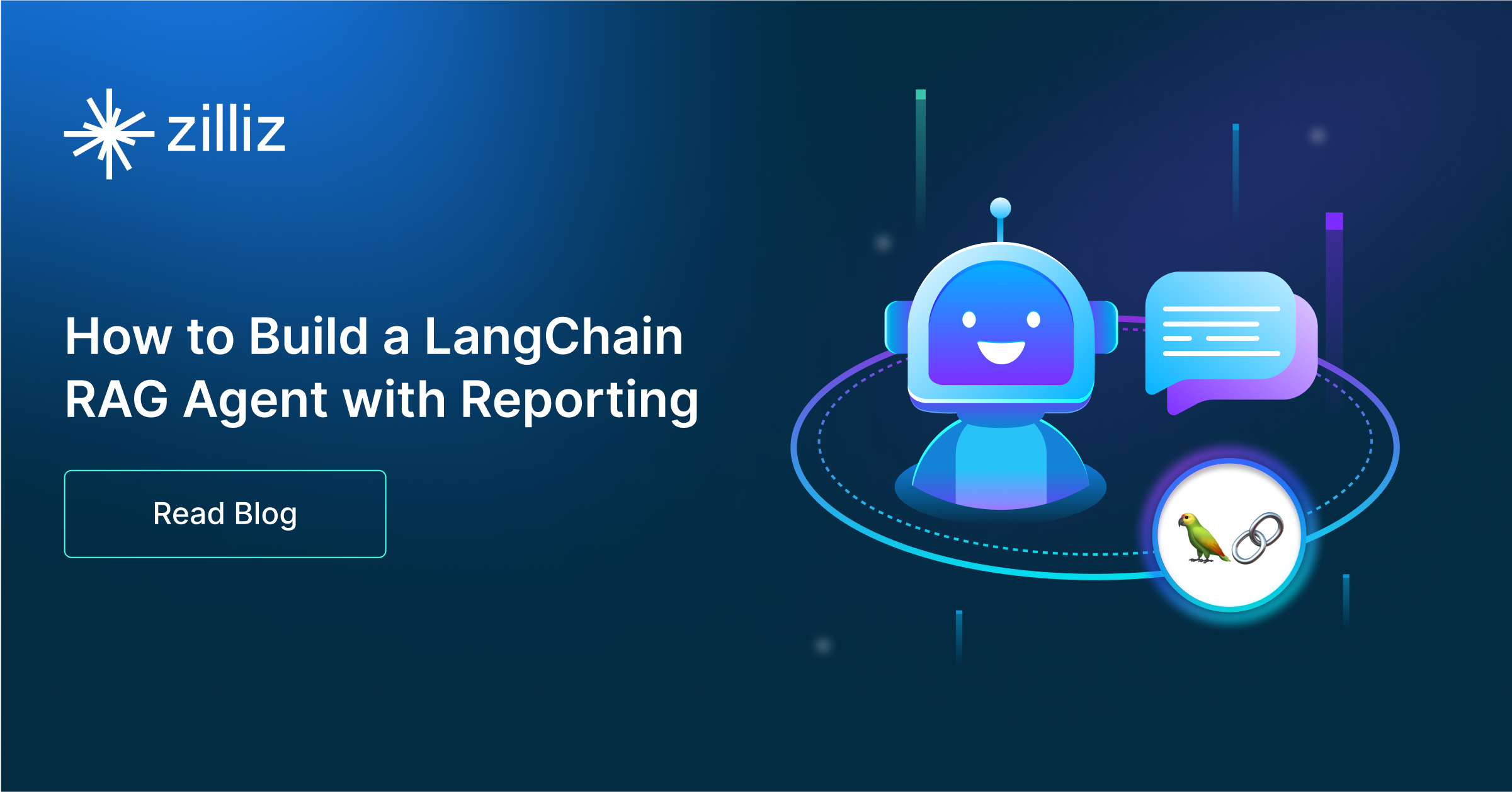Build RAG Chatbot with Haystack, Haystack In-memory store, Anthropic Claude 3.7 Sonnet, and BAAI bge-large-en-v1.5
Introduction to RAG
Retrieval-Augmented Generation (RAG) is a game-changer for GenAI applications, especially in conversational AI. It combines the power of pre-trained large language models (LLMs) like OpenAI’s GPT with external knowledge sources stored in vector databases such as Milvus and Zilliz Cloud, allowing for more accurate, contextually relevant, and up-to-date response generation. A RAG pipeline usually consists of four basic components: a vector database, an embedding model, an LLM, and a framework.
Key Components We'll Use for This RAG Chatbot
This tutorial shows you how to build a simple RAG chatbot in Python using the following components:
- Haystack: An open-source Python framework designed for building production-ready NLP applications, particularly question answering and semantic search systems. Haystack excels at retrieving information from large document collections through its modular architecture that combines retrieval and reader components. Ideal for developers creating search applications, chatbots, and knowledge management systems that require efficient document processing and accurate information extraction from unstructured text.
- Haystack in-memory store: a very simple, in-memory document store with no extra services or dependencies. It is great for experimenting with Haystack, and we do not recommend using it for production. If you want a much more scalable solution for your apps or even enterprise projects, we recommend using Zilliz Cloud, which is a fully managed vector database service built on the open-source Milvusand offers a free tier supporting up to 1 million vectors.)
- Anthropic Claude 3.7 Sonnet: A versatile multimodal AI model optimized for enterprise applications, excelling in complex reasoning, multilingual tasks, and data analysis. Its strengths include rapid processing, high accuracy, and robust contextual understanding, ideal for content generation, customer support automation, R&D acceleration, and scalable AI-driven workflows. Combines performance with cost-efficiency for real-world deployment.
- BAAI bge-large-en-v1.5: A dense embedding model optimized for semantic retrieval, excelling in capturing nuanced text semantics for tasks like retrieval-augmented generation (RAG), semantic search, and clustering. Its strengths include high accuracy across diverse domains, robust handling of complex queries, and efficient scalability. Ideal for enterprise search engines, recommendation systems, and knowledge-intensive NLP applications requiring precise contextual understanding.
By the end of this tutorial, you’ll have a functional chatbot capable of answering questions based on a custom knowledge base.
Note: Since we may use proprietary models in our tutorials, make sure you have the required API key beforehand.
Step 1: Install and Set Up Haystack
import os
import requests
from haystack import Pipeline
from haystack.components.converters import MarkdownToDocument
from haystack.components.preprocessors import DocumentSplitter
from haystack.components.writers import DocumentWriter
Step 2: Install and Set Up Anthropic Claude 3.7 Sonnet
To use Anthropic models, you need an Anthropic API key. You can provide this key in one of the following ways:
- The recommended approach is to set it as the
ANTHROPIC_API_KEYenvironment variable. - Alternatively, you can pass it directly when initializing the component using Haystack’s Secret API:
Secret.from_token("your-api-key-here").
When configuring Anthropic models, make sure to define the Anthropic model you want to use by specifying it in the model parameter.
This component generates text based on a given prompt. Additionally, you can customize the generation process by providing extra parameters available in the Anthropic Messaging API. These parameters can be passed using generation_kwargs, either during initialization or when calling the run() method. To explore all available options, refer to the Anthropic documentation.
Finally, the run() method requires a single string as input to generate text.
Now let's install the anthropic-haystack package to use the AnthropicGenerator:
pip install anthropic-haystack
from haystack_integrations.components.generators.anthropic import AnthropicGenerator
generator = AnthropicGenerator(model="claude-3-7-sonnet-latest")
Step 3: Install and Set Up BAAI bge-large-en-v1.5
from haystack import Document
from haystack.components.embedders import SentenceTransformersDocumentEmbedder
from haystack.components.embedders import SentenceTransformersTextEmbedder
doc_embedder = SentenceTransformersDocumentEmbedder(model="BAAI/bge-large-en-v1.5")
doc_embedder.warm_up()
text_embedder = SentenceTransformersTextEmbedder(model="BAAI/bge-large-en-v1.5")
text_embedder.warm_up()
Step 4: Install and Set Up Haystack In-memory store
from haystack.document_stores.in_memory import InMemoryDocumentStore
from haystack.components.retrievers import InMemoryEmbeddingRetriever
document_store = InMemoryDocumentStore()
retriever=InMemoryEmbeddingRetriever(document_store=document_store))
Step 5: Build a RAG Chatbot
Now that you’ve set up all components, let’s start to build a simple chatbot. We’ll use the Milvus introduction doc as a private knowledge base. You can replace it your own dataset to customize your RAG chatbot.
url = 'https://raw.githubusercontent.com/milvus-io/milvus-docs/refs/heads/v2.5.x/site/en/about/overview.md'
example_file = 'example_file.md'
response = requests.get(url)
with open(example_file, 'wb') as f:
f.write(response.content)
file_paths = [example_file] # You can replace it with your own file paths.
indexing_pipeline = Pipeline()
indexing_pipeline.add_component("converter", MarkdownToDocument())
indexing_pipeline.add_component("splitter", DocumentSplitter(split_by="sentence", split_length=2))
indexing_pipeline.add_component("embedder", document_embedder)
indexing_pipeline.add_component("writer", DocumentWriter(document_store))
indexing_pipeline.connect("converter", "splitter")
indexing_pipeline.connect("splitter", "embedder")
indexing_pipeline.connect("embedder", "writer")
indexing_pipeline.run({"converter": {"sources": file_paths}})
# print("Number of documents:", document_store.count_documents())
question = "What is Milvus?" # You can replace it with your own question.
retrieval_pipeline = Pipeline()
retrieval_pipeline.add_component("embedder", text_embedder)
retrieval_pipeline.add_component("retriever", retriever)
retrieval_pipeline.connect("embedder", "retriever")
retrieval_results = retrieval_pipeline.run({"embedder": {"text": question}})
# for doc in retrieval_results["retriever"]["documents"]:
# print(doc.content)
# print("-" * 10)
from haystack.utils import Secret
from haystack.components.builders import PromptBuilder
retriever=InMemoryEmbeddingRetriever(document_store=document_store)
text_embedder = SentenceTransformersTextEmbedder(model="BAAI/bge-large-en-v1.5")
text_embedder.warm_up()
prompt_template = """Answer the following query based on the provided context. If the context does
not include an answer, reply with 'I don't know'.\n
Query: {{query}}
Documents:
{% for doc in documents %}
{{ doc.content }}
{% endfor %}
Answer:
"""
rag_pipeline = Pipeline()
rag_pipeline.add_component("text_embedder", text_embedder)
rag_pipeline.add_component("retriever", retriever)
rag_pipeline.add_component("prompt_builder", PromptBuilder(template=prompt_template))
rag_pipeline.add_component("generator", generator)
rag_pipeline.connect("text_embedder.embedding", "retriever.query_embedding")
rag_pipeline.connect("retriever.documents", "prompt_builder.documents")
rag_pipeline.connect("prompt_builder", "generator")
results = rag_pipeline.run({"text_embedder": {"text": question}, "prompt_builder": {"query": question},})
print('RAG answer:\n', results["generator"]["replies"][0])
Optimization Tips
As you build your RAG system, optimization is key to ensuring peak performance and efficiency. While setting up the components is an essential first step, fine-tuning each one will help you create a solution that works even better and scales seamlessly. In this section, we’ll share some practical tips for optimizing all these components, giving you the edge to build smarter, faster, and more responsive RAG applications.
Haystack optimization tips
To optimize Haystack in a RAG setup, ensure you use an efficient retriever like FAISS or Milvus for scalable and fast similarity searches. Fine-tune your document store settings, such as indexing strategies and storage backends, to balance speed and accuracy. Use batch processing for embedding generation to reduce latency and optimize API calls. Leverage Haystack's pipeline caching to avoid redundant computations, especially for frequently queried documents. Tune your reader model by selecting a lightweight yet accurate transformer-based model like DistilBERT to speed up response times. Implement query rewriting or filtering techniques to enhance retrieval quality, ensuring the most relevant documents are retrieved for generation. Finally, monitor system performance with Haystack’s built-in evaluation tools to iteratively refine your setup based on real-world query performance.
Haystack in-memory store optimization tips
Haystack in-memory store is just a very simple, in-memory document store with no extra services or dependencies. We recommend that you just experiment it with RAG pipeline within your Haystack framework, and we do not recommend using it for production. If you want a much more scalable solution for your apps or even enterprise projects, we recommend using Zilliz Cloud, which is a fully managed vector database service built on the open-source Milvusand offers a free tier supporting up to 1 million vectors
Anthropic Claude 3.7 Sonnet optimization tips
Optimize prompts by structuring retrieved context with clear XML tags or markdown headers to enhance Claude’s parsing efficiency. Use dynamic context window management, prioritizing high-relevance chunks while truncating redundant content. Implement query-aware document reranking to surface critical information early. Fine-tune temperature (0.2-0.5) for factual consistency and enable streaming for latency-sensitive applications. Cache frequent query embeddings to reduce reprocessing overhead. Leverage system prompts to enforce response constraints and validate outputs against retrieval sources to mitigate hallucinations. Monitor token usage per API call to balance cost and performance.
BAAI bge-large-en-v1.5 optimization tips
To optimize BAAI bge-large-en-v1.5 in RAG, ensure input text is clean and preprocessed (remove noise, truncate to 512 tokens). Use the model’s instruction prefix ("Represent this sentence for retrieval: ") for query embeddings to align with its training. Batch embedding generation for efficiency, and normalize outputs before similarity comparisons. Fine-tune on domain-specific data if retrieval accuracy lags. Use FAISS or HNSW for fast vector search, and quantize embeddings to reduce memory. Regularly evaluate recall@k to balance speed and relevance. Leverage GPU acceleration and optimize temperature/sampling for generation coherence.
By implementing these tips across your components, you'll be able to enhance the performance and functionality of your RAG system, ensuring it’s optimized for both speed and accuracy. Keep testing, iterating, and refining your setup to stay ahead in the ever-evolving world of AI development.
RAG Cost Calculator: A Free Tool to Calculate Your Cost in Seconds
Estimating the cost of a Retrieval-Augmented Generation (RAG) pipeline involves analyzing expenses across vector storage, compute resources, and API usage. Key cost drivers include vector database queries, embedding generation, and LLM inference.
RAG Cost Calculator is a free tool that quickly estimates the cost of building a RAG pipeline, including chunking, embedding, vector storage/search, and LLM generation. It also helps you identify cost-saving opportunities and achieve up to 10x cost reduction on vector databases with the serverless option.
 Calculate your RAG cost
Calculate your RAG cost
What Have You Learned?
By diving into this tutorial, you’ve discovered how to weave together cutting-edge tools to create a powerful RAG system that breathes life into your applications! You learned how Haystack acts as the backbone, orchestrating the flow of data between components with flexibility and ease. The Haystack In-Memory Store stepped in as your lightning-fast vector database, keeping embeddings ready for instant retrieval without the fuss of complex setups. Then came the magic of BAAI bge-large-en-v1.5, transforming raw text into rich, meaningful embeddings that capture the essence of your data—like turning words into a language your system understands. And who could forget Anthropic Claude 3 Sonnet? This LLM became your creative partner, synthesizing retrieved information into clear, human-like responses that feel both natural and insightful. Together, these pieces formed a seamless pipeline: ingest data, embed it, retrieve relevant context, and generate answers that dazzle users. Along the way, you picked up pro tips—like tweaking chunk sizes for accuracy or balancing speed with resource use—and even discovered tools like the free RAG cost calculator to keep your projects budget-friendly and high-performing.
But this isn’t just about following steps—it’s about unlocking potential. You’ve seen firsthand how these technologies empower you to build smarter, more responsive applications, whether for customer support, research, or creative storytelling. The tutorial gave you the blueprint, but you hold the creativity to innovate. Imagine optimizing retrieval strategies, experimenting with hybrid models, or tailoring outputs to your unique audience. The future of intelligent apps is yours to shape! So grab those tools, fire up your IDE, and start building. Every line of code, every experiment, every “aha!” moment brings you closer to something extraordinary. The RAG revolution is here—and you’re already leading the charge. Let’s make it unforgettable! 🚀
Further Resources
🌟 In addition to this RAG tutorial, unleash your full potential with these incredible resources to level up your RAG skills.
- How to Build a Multimodal RAG | Documentation
- How to Enhance the Performance of Your RAG Pipeline
- Graph RAG with Milvus | Documentation
- How to Evaluate RAG Applications - Zilliz Learn
- Generative AI Resource Hub | Zilliz
We'd Love to Hear What You Think!
We’d love to hear your thoughts! 🌟 Leave your questions or comments below or join our vibrant Milvus Discord community to share your experiences, ask questions, or connect with thousands of AI enthusiasts. Your journey matters to us!
If you like this tutorial, show your support by giving our Milvus GitHub repo a star ⭐—it means the world to us and inspires us to keep creating! 💖
- Introduction to RAG
- Key Components We'll Use for This RAG Chatbot
- Step 1: Install and Set Up Haystack
- Step 2: Install and Set Up Anthropic Claude 3.7 Sonnet
- Step 3: Install and Set Up BAAI bge-large-en-v1.5
- Step 4: Install and Set Up Haystack In-memory store
- Step 5: Build a RAG Chatbot
- Optimization Tips
- RAG Cost Calculator: A Free Tool to Calculate Your Cost in Seconds
- What Have You Learned?
- Further Resources
- We'd Love to Hear What You Think!
Content
Vector Database at Scale
Zilliz Cloud is a fully-managed vector database built for scale, perfect for your RAG apps.
Try Zilliz Cloud for Free


